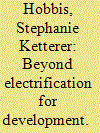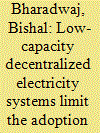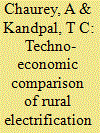|
|
|
Sort Order |
|
|
|
Items / Page
|
|
|
|
|
|
|
| Srl | Item |
| 1 |
ID:
105822


|
|
|
|
|
| Publication |
2011.
|
| Summary/Abstract |
This paper examines the multiple benefits of the adoption of Solar Home Systems (SHS) and discusses the dissemination potential for sustainable rural livelihoods in developing countries. Based on a household survey conducted in rural Bangladesh, we first identify the impact of SHS on the reduction in energy costs and compare purchasing costs. We then examine household lifestyle changes following the adoption of SHS. Finally, we consider several price-reduction scenarios to examine the potential demand for SHS and to evaluate its future dissemination potential. The results of the analysis indicate that households with SHS successfully reduce their consumption of kerosene and dependency on rechargeable batteries, with the cost reductions accounting for some 20-30% of monthly expenditures on SHS. Moreover, most households with SHS can enjoy its benefits, including electric lighting, watching television, and the ease of mobile phone recharging at home. Further, the price reduction can make possible potential demand in more than 60% of households without SHS, while additional price reductions promote the purchase of even larger SHS packages. This study concludes that even though the scale of single SHS is small, the micro-benefits for each household and the dissemination potential are substantial.
|
|
|
|
|
|
|
|
|
|
|
|
|
|
|
|
| 2 |
ID:
180641


|
|
|
|
|
| Summary/Abstract |
Based on an in-depth examination of the acquisition, use, maintenance and deterioration of solar home systems in a village in Malaita, Solomon Islands, this article challenges the analytical focus of current debates on electrification in Pacific Island countries – why Pacific Island countries have not yet sufficiently electrified to achieve their development goals. Alternatively it examines what is, how, in this case, rural Solomon Islanders have integrated already available electricity into their daily lives. This perspectival shift highlights how rural Solomon Islanders have developed an energy identity that corresponds to their needs, interests and values, rather than those of national and international actors. It re-emphasises the struggles of national and international electrification initiatives in rural environments, linking them to a broader distrust in the motivations of external actors. At the same time, it reveals how, throughout their life cycle, rural solar home systems have become integrated into processes of social reproduction rather than development aspirations. Contrary to dominant debates, rural solar home systems matter most in the opportunities that they provide for reciprocal exchange than for what the electricity enables them to do.
|
|
|
|
|
|
|
|
|
|
|
|
|
|
|
|
| 3 |
ID:
088032


|
|
|
|
|
| Publication |
2009.
|
| Summary/Abstract |
About 78 million rural households in India reportedly lack access to grid electricity. About 67 million of them use kerosene for lighting. Government of India is promoting the use of solar home systems (SHS) as one of the options for meeting lighting requirements in households in remote and less inhabited villages. About 363,399 SHS were reportedly disseminated across the country by December 2007. Apart from meeting the basic lighting need of the households, SHS also help in abating the emissions of green house gases (GHGs) by directly displacing the use of kerosene in households that currently use it for lighting. This study has attempted at estimating the CO2 mitigation potential of SHS in India by studying the potential for their diffusion and the appropriate baseline. Subsequently, the scope for cost reduction to the user due to carbon finance, if received, is also studied. It is found that carbon finance could reduce the effective burden of SHS to the user by 19% if carbon prices were $10/tCO2 and no transaction costs were involved in getting the carbon revenues. These benefits are also estimated for scenarios where transaction costs are incurred by the project proponent in getting the carbon benefits.
|
|
|
|
|
|
|
|
|
|
|
|
|
|
|
|
| 4 |
ID:
117289


|
|
|
|
|
| Publication |
2013.
|
| Summary/Abstract |
One of the key challenges of energy access in emerging markets and developing countries is how to reach households and communities that are unlikely to get a grid connection in the long term or those that are connected to the grid but suffer from regular blackouts or low voltage. By surveying entrepreneurs selling Solar Home Systems (SHSs) on a commercial basis in emerging and developing countries, this study is one of the first attempts to quantify the key elements of four potential Product Service Systems (PSSs): Cash, Credit, Leasing and Fee-for-Service. Whereas the Fee-for-Service approach was found to be suitable only under certain conditions, all PSSs share two key elements for successful market deployment: one or more years of maintenance, and customer support in financing these customers' new asset. Moreover, it appears that private sector companies are in principle able to deliver SHSs to households with incomes greater than USD 1000 per year. The implications for policy makers and development aid agencies are, first, to include maintenance services into public programmes or public-private partnerships and, second, to explicitly consider financial risks for entrepreneurs (e.g., customer commitment and repayment conditions).
|
|
|
|
|
|
|
|
|
|
|
|
|
|
|
|
| 5 |
ID:
105729


|
|
|
|
|
| Publication |
2011.
|
| Summary/Abstract |
Solar home systems (SHSs) are a promising electrification option for many households in the developing world. In most countries SHSs are at an early stage of dissemination, and thus face a hurdle common to many emerging alternative energy technologies: many people do not know enough about them to decide whether to adopt one or not. This study uses survey data collected in Nicaragua to investigate characteristics that predict the knowledge and adoption of SHSs among the rural population. First, a series of probit models is used to model the determinants of four measures of SHS knowledge. Next, a biprobit model with sample selection is employed to investigate the factors that predict SHS adoption, conditional on having sufficient knowledge to make an adoption decision. Comparison of the biprobit formulation to a standard probit model of adoption affirms its value. This study identifies multiple determinants of SHS knowledge and adoption, offers several practical recommendations to project planners, and provides an analytical framework for future work in this policy-relevant area.
|
|
|
|
|
|
|
|
|
|
|
|
|
|
|
|
| 6 |
ID:
190587


|
|
|
|
|
| Summary/Abstract |
The adoption and use of electronic appliances generally contribute to higher productivity and thus are key to ameliorate living standards of rural households. A wide range of decentralized electricity systems has been used to power remote parts of Nepal. How these systems facilitate the adoption of electronic appliances, is a question under explored in the existing energy policy literature. This study bridges this gap by comparing the electronic appliance adoption among households that use micro-hydropower and solar home systems against traditional lighting solutions and grid electricity in Nepal. Applying the two-stage least-square method to data from Nepal's population and household census of 2011, we found solar home systems do not increase the use of high-wattage electronic appliances such as televisions and fridges when compared to kerosene, but micro-hydro plants and grid electricity do. This finding indicates that low-capacity electricity sources like solar home systems appear to be limited to facilitate the adoption of high-wattage electronic appliances. It is recommended that energy access policies should look beyond providing basic access to electricity for lighting and prioritize the provisioning of electricity sources that support the use of high-wattage electricity appliances.
|
|
|
|
|
|
|
|
|
|
|
|
|
|
|
|
| 7 |
ID:
103450


|
|
|
|
|
| Publication |
2011.
|
| Summary/Abstract |
This study explores the socio-technical barriers to Solar Home Systems (SHS) in Papua New Guinea. The authors collected primary data through semi-structured research interviews conducted over the course of February 2010-April 2010. Respondents included government officials, financiers, planners, commercial distributors and companies, teachers and rural villagers in addition to members of civil society, academics, consultants, and trainers. These interviews were supplemented with site visits to Port Moresby, Goroka, and Madang, and field research in the villages of Akameku, Asaroka, Lufa, Kundiawa, Okifa, Simbu, and Talidig. The study draws from these interviews and visits to discuss four types of barriers. Technical barriers relate to substandard equipment and logistical problems. Economic barriers include high rates of poverty, misconceptions about the role of currency, and lack of financing. Political barriers include poor institutional capacity and a government commitment to fossil-fueled grid electrification. Social barriers encompass unrealistic expectations about what SHS can provide along with jealousy, theft, vandalism, and unfamiliarity with solar technology.
|
|
|
|
|
|
|
|
|
|
|
|
|
|
|
|
| 8 |
ID:
096152


|
|
|
|
|
| Publication |
2010.
|
| Summary/Abstract |
Solar home systems are typically used for providing basic electricity services to rural households that are not connected to electric grid. Off-grid PV power plants with their own distribution network (micro/minigrids) are also being considered for rural electrification. A techno-economic comparison of the two options to facilitate a choice between them is presented in this study on the basis of annualised life cycle costs (ALCC) for same type of loads and load patterns for varying number of households and varying length and costs of distribution network. The results highlight that microgrid is generally a more economic option for a village having a flat geographic terrain and more than 500 densely located households using 3-4 low power appliances (e.g. 9 W CFLs) for an average of 4 h daily. The study analyses the viability of the two options from the perspectives of the user, an energy service company and the society.
|
|
|
|
|
|
|
|
|
|
|
|
|
|
|
|
|
|
|
|
|